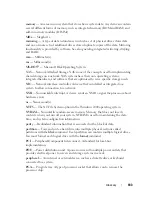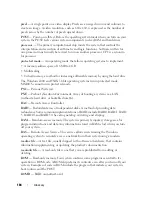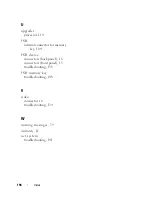
180
Glossary
expansion bus
— Your system contains an expansion bus that allows the processor to
communicate with controllers for peripherals, such as NICs.
expansion card
— An add-in card, such as a NIC or SCSI adapter, that plugs into an
expansion-card connector on the system board. An expansion card adds some
specialized function to the system by providing an interface between the expansion
bus and a peripheral.
expansion-card connector
— A connector on the system board or riser board for
plugging in an expansion card.
F
— Fahrenheit.
FAT
— File allocation table. The file system structure used by MS-DOS
®
to organize
and keep track of file storage. The Microsoft
®
Windows
®
operating systems can
optionally use a FAT file system structure.
flash memory
— A type of EEPROM chip that can be reprogrammed from a utility on
diskette while still installed in a system; most EEPROM chips can only be rewritten
with special programming equipment.
format
— To prepare a hard drive or diskette for storing files. An unconditional format
deletes all data stored on the disk.
FSB
— Front-side bus. The FSB is the data path and physical interface between the
processor and the main memory (RAM).
ft
— Feet.
FTP
— File transfer protocol.
g
— Gram(s).
G
— Gravities.
Gb
— Gigabit(s); 1024 megabits or 1,073,741,824 bits.
GB
— Gigabyte(s); 1024 megabytes or 1,073,741,824 bytes. However, when referring
to hard-drive capacity, the term is usually rounded to 1,000,000,000 bytes.
graphics mode
— A video mode that can be defined as
x
horizontal by
y
vertical pixels
by
z
colors.
group
— As it relates to DMI, a group is a data structure that defines common
information, or attributes, about a manageable component.
guarding
— A type of data redundancy in which a set of physical drives stores data and
an additional drive stores parity data. See also
mirroring
,
striping
, and
RAID
.
h
— Hexadecimal. A base-16 numbering system, often used in programming to
identify addresses in the system’s RAM and I/O memory addresses for devices. In text,
hexadecimal numbers are often followed by
h
.
Summary of Contents for POWEREDGE T300
Page 10: ...10 Contents ...
Page 132: ...132 Installing System Components ...
Page 174: ...174 Jumpers and Connectors ...
Page 176: ...176 Getting Help ...
Page 188: ...188 Glossary ...















































